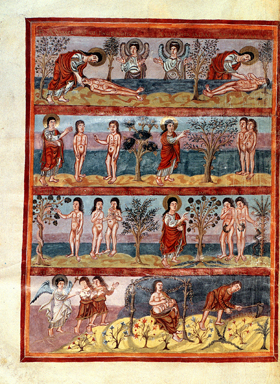| Anonymous Grandval Bible, Adam and Eve Approx. 840 AC British Library London, England |
|
Rights (Photo / Work):
CC0 // Wikipedia List of sources: |
In the Early Middle Ages, the painting style changed in so far as figures were depicted less vividly or physically. The inspired sculptures of earlier times, like Greek culture were a thing of the past since „the focus on the physical and secularistic life wasn't compatible with the Christian ideas in the long run".[1] The genitals were connected with sinfulness and equated with the evil. The figures in this representation are missing gender-specific features, in both cases the genitals are not depicted. Some medieval religious scripts promoted the notion that mankind was originally created by God without genitals which were formed subsequently after „banishment from paradise".[2] Due to the „Fall of Man", life became laborious, desire and sexuality were connoted negatively. For the church father Gregor of Nyssa differentiated sexes after the „Fall of Man" were necessary in order to reproduce life. Augustinus argues that Adam and Eve already possessed genitals before the „Fall of Man" in order to reproduce, but only afterwards they felt lust and desire. In his opinion, this was a good cause to be ashamed and to hide the genitals.[3] Out of these reasons, it becomes obvious that there are no vulva depictions of this time, except in a defamatory way, like figures pointing to the vulva or „sheela-na-gigs" in Ireland. Besides, in the Middle Ages the vulva was interpreted as gateway to hell and thus additionally connotated negatively. (Translation: C. Wilhelm)
|

